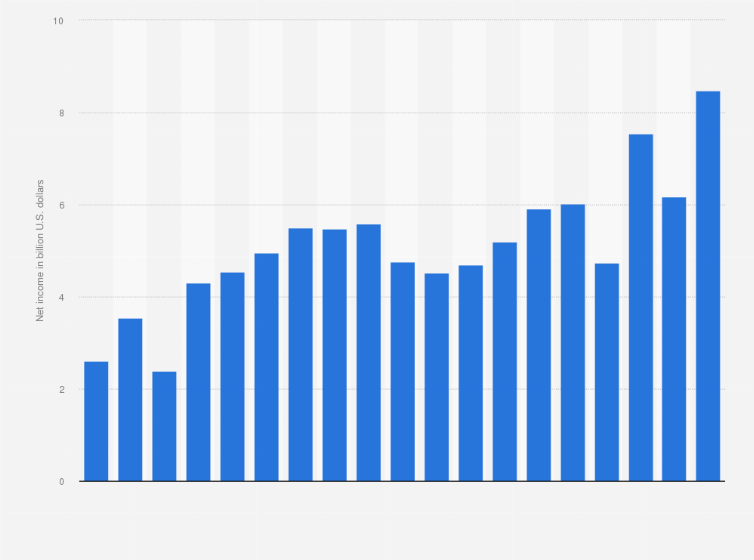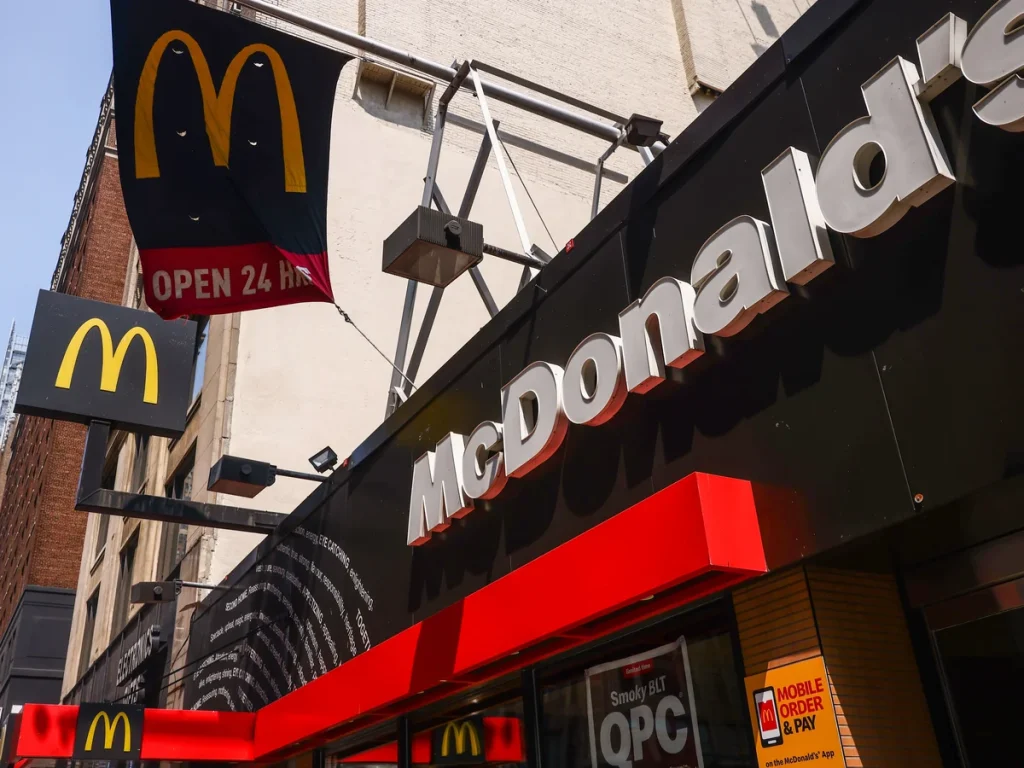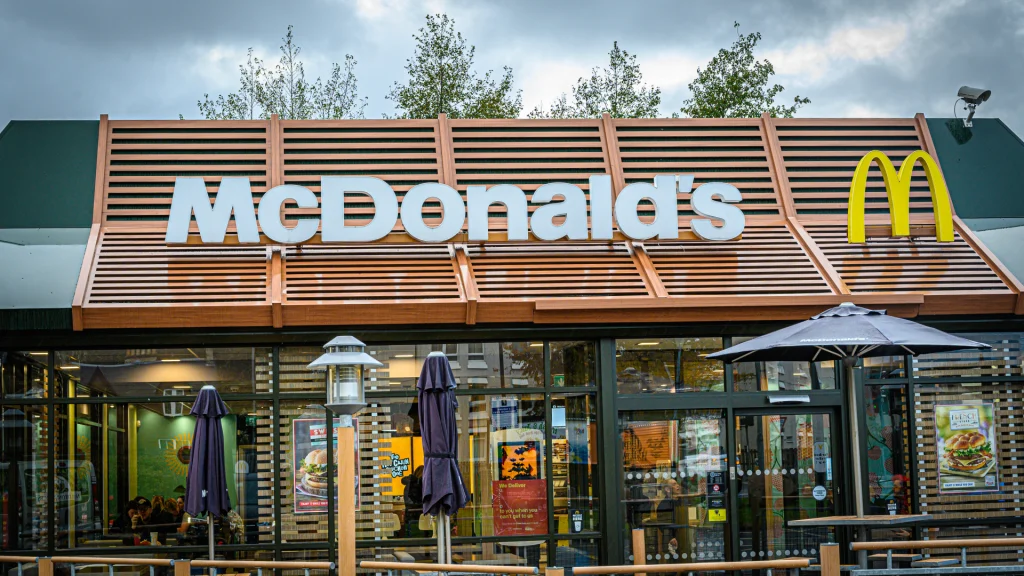How Much Is McDonalds Worth? Shocking Figures 2024
Are You Curious To Know How Much Is McDonalds Worth? As of 2024, McDonald’s market capitalization stands impressively at over $212 billion, showcasing its status as a titan in the fast-food industry. However, this valuation is not just a reflection of stock performance; it encapsulates the brand’s extensive global reach and operational model.
McDonald’s revenue streams, primarily from company-operated and franchised restaurants, highlight its unique business structure. With approximately 93% of its outlets being franchised, the parent company has strategically positioned itself to maximize profits while minimizing operational burdens.
Table of Contents
McDonalds Key Details
| Attribute | Details |
| Founded | May 15, 1940 |
| Founders | Richard and Maurice McDonald |
| First Restaurant Location | San Bernardino, California |
| Initial Concept | A drive-in restaurant focused on barbecue items |
| Innovative System | Introduced the “Speedee Service System” for fast food service |
| Family Background | McDonald brothers moved from Manchester, New Hampshire to Hollywood in the late 1930s |
| Father’s Food Stand | Patrick McDonald opened The Airdrome food stand in Monrovia, California in 1937 |
| Menu Shift | In 1948, focused on hamburgers, dropping barbecue items |
| Architectural Innovation | New restaurant design by Stanley Clark Meston featuring the iconic “Golden Arches” |
| First Franchisee | Neil Fox opened the first franchise in Phoenix, Arizona in 1953 |
| Ray Kroc’s Involvement | Kroc visited the McDonald brothers in 1954 and proposed national franchising |
| Real Estate Model | Implemented by Harry J. Sonneborn to own land for franchises, crucial for financial growth |
| Major Expansion | By 1960, gross revenue reached $56 million annually |
| First International Locations | San José, Costa Rica in 1970; first European restaurant in Zaandam, Netherlands in 1971 |
| Notable Menu Items | Introduction of the Filet-O-Fish in 1962 and Big Mac in 1967 |
| Crisis Management | Responded to public relations crises in the early 1990s, including bombings and murders related to McDonald’s restaurants |
| Current Operations | Over 38,000 locations globally, with a shift to all-day breakfast introduced in 2015 |
| Recent Developments | Suspended operations in Russia in March 2022 in response to geopolitical issues |
Understanding Market Capitalization

Market capitalization, or market cap, is a straightforward yet powerful metric. It calculates a company’s value based on its stock price and outstanding shares. For example, McDonald’s, with 747.24 million shares at $252.40 each, has a market cap of over $212 billion. This method is favored for its simplicity and effectiveness.
It allows investors to compare companies of different sizes easily. Unlike share price alone, market cap offers a clearer picture of a company’s overall worth. It’s a standard tool for investors and analysts when assessing a business’s scale and financial health. Remember that the market cap fluctuates with the stock market, reflecting the company’s real-time valuation.
The Evolution of McDonald’s Valuation
The journey to understanding how much mcdonald’s is worth spans decades of strategic evolution. Initially founded by the McDonald brothers in 1940, the company underwent a significant transformation when Ray Kroc took over in 1961. Under Kroc’s leadership, McDonald’s scaled new heights, becoming a global powerhouse. Transitioning from a single restaurant to a franchising behemoth, McDonald’s expanded rapidly.
Its valuation soared as it optimized its operations and capitalized on global market trends. Each strategic move, including introducing new products and technological innovations, added billions to its market cap. By 2024, McDonald’s market capitalization reflects these cumulative efforts at an astonishing $212 billion. This remarkable growth story exemplifies how effective leadership and strategic planning can profoundly impact a company’s valuation.
How Market Cap Levels the Playing Field?
The market cap provides a more precise comparison between companies. Unlike stock prices, it considers both share price and outstanding shares. For instance, McDonald’s market cap is over $212 billion despite its share price being around $252.40. Contrast this with White Mountains Insurance Group, which has a share price of $1,098 but a market cap of only $3.31 billion.
This demonstrates that share price alone doesn’t reveal a company’s size. Market cap levels the playing field by offering a consistent metric. It helps answer how much is McDonald’s worth compared to other giants. This standardization is crucial for investors analyzing companies of different sizes. It provides a more accurate financial landscape, allowing better investment decisions.
Market Cap Versus Other Valuation Metrics

- Price-to-Earnings (P/E) Ratio:
This metric evaluates a company’s current share price relative to its per-share earnings. Investors use it to determine if a stock is overvalued or undervalued based on its historical earnings.
- Earnings Per Share (EPS):
EPS measures a company’s profitability by dividing net earnings by the number of outstanding shares. It’s a vital indicator of a company’s financial health and is often used alongside the P/E ratio.
- Book Value:
This represents a company’s net asset value, calculated by total assets minus total liabilities. Investors use book value to assess whether a stock trades above or below its worth.
- Enterprise Value (EV):
EV includes a company’s market cap, debt, and cash reserves, providing a comprehensive view of its total value. It’s often used in conjunction with EBITDA to assess takeover prices.
- Price-to-Book (P/B) Ratio:
This metric compares a company’s market value to its book value. A lower P/B ratio might indicate a potentially undervalued stock, whereas a higher ratio could suggest overvaluation.
Fluctuations in McDonald’s Market Cap
- Early 2024 Volatility:
In early 2024, McDonald’s market cap experienced notable fluctuations. Economic uncertainties and changing consumer behaviors caused the stock price to vary significantly.
- Impact of Quarterly Earnings Reports:
Quarterly earnings releases played a crucial role in McDonald’s market cap variations. Positive reports often led to spikes in valuation, while missed expectations triggered declines.
- Influence of Global Expansion Plans:
Announcements related to new market entries or expansion plans in emerging economies affected the market cap. Investors reacted positively to news of strategic international growth.
- Technological Innovations:
Implementing new technologies, like automation in kitchens and digital ordering systems, also influenced McDonald’s market cap. Innovations aimed at improving efficiency and customer experience drove investor confidence.
- Competitive Pressures:
Increased competition from other fast-food giants periodically impacted McDonald’s market cap. Investors closely monitored strategic responses to competitor actions, causing fluctuations.
Net Worth as an Alternative to Market Cap

Net worth, also known as shareholders’ equity, offers a different perspective. It represents the company’s actual financial value. Net worth is calculated by subtracting total liabilities from total assets. While market cap fluctuates with stock prices, net worth reflects a more stable metric. Some investors prefer this method as it’s less influenced by market volatility.
For McDonald’s, net worth gives insight into its intrinsic value, encompassing tangible and intangible assets. However, accounting practices can affect the reported net worth. For instance, asset depreciation or goodwill adjustments might alter the figures. Despite these variables, net worth remains a crucial metric for those looking beyond market cap. It’s a valuable tool for evaluating long-term financial health and stability.
The Simplicity of McDonald’s Balance Sheet
McDonald’s balance sheet is surprisingly straightforward for such a large company. It mainly features two key revenue sources: sales from company-operated restaurants and income from franchised locations. This dual revenue model simplifies financial tracking and analysis. About 93% of McDonald’s outlets are franchised, minimizing operational costs. This setup ensures consistent revenue streams while reducing overhead. McDonald’s focuses on maintaining a lean balance sheet by leveraging franchising.
Transitioning to a franchising model has streamlined its financial operations. Additionally, the company keeps its liabilities in check, maintaining a healthy debt-to-equity ratio. This simplicity and strategic approach make McDonald’s a robust and attractive investment option. Despite its global reach, McDonald’s financial structure remains precise and efficient.
Revenue from Company-Operated Restaurants
McDonald’s generates significant revenue from its company-operated restaurants. These outlets directly contribute to the corporation’s earnings, unlike franchised locations. When customers buy items like the Big Mac, fries, or McFlurries, the revenue goes straight to McDonald’s. These direct sales have played a crucial role in transitioning from a smaller chain to a massive corporation. For example, a Big Mac priced at around $4.39 significantly boosts daily revenue.
With many outlets globally, the cumulative earnings are substantial. Moreover, company-operated restaurants serve as testing grounds for new products. This allows McDonald’s to gauge consumer interest and refine offerings before launching them worldwide. Consequently, these locations are not just revenue generators but also innovation hubs for the company.
Revenue from Franchised Restaurants

Revenue from McDonald’s franchised restaurants significantly boosts the company’s earnings. Each franchisee pays initial fees, ongoing royalties, and rents. Royalties are typically a percentage of sales, ensuring consistent revenue. Additionally, franchisees bear operational costs, easing McDonald’s financial burdens. This model supports expansion with minimal capital investment. For example, franchisees pay around 4% of monthly sales as royalties.
Rent payments, often based on a percentage of sales, further add to the income. Transitioning to a franchise-heavy model has allowed rapid global growth. With about 93% of its outlets franchised, McDonald’s leverages this setup to enhance profitability. This approach maximizes revenue while maintaining a lean operational structure. Franchised restaurants also drive brand consistency and quality control, bolstering McDonald’s market position.
The Role of Accounting Methods in Valuation
Accounting methods significantly impact how much mcdonald’s is worth. These methods determine how assets, liabilities, and revenues are recorded. For instance, asset depreciation reduces the book value over time, affecting net worth. Additionally, the valuation of intangible assets like trademarks can vary. Goodwill, the premium paid over fair value in acquisitions, is another factor. Adjustments in these areas can alter financial statements.
Different accounting standards, such as GAAP or IFRS, may result in varying valuations. Transitioning to another accounting standard can lead to restatements of financial results. Investors must consider these methods when evaluating McDonald’s economic health. Accounting policies on revenue recognition also play a crucial role. McDonald’s methods may impact reported earnings, thus influencing its valuation metrics.
Comparing McDonald’s to Other Fast-Food Giants
- Revenue Comparison:
With its unique blend of company-operated and franchised restaurants, McDonald’s generates substantial revenue. Competitors like Burger King and Wendy’s rely more heavily on franchised models, impacting their revenue structures differently.
- Market Cap Comparison:
As of 2024, McDonald’s market cap surpasses $212 billion, dwarfing competitors like Yum! Brands, including KFC and Taco Bell, have significantly lower market caps. This metric highlights McDonald’s dominance in the fast-food sector.
- Global Presence:
McDonald’s expansive global reach includes over 38,000 locations worldwide. In contrast, despite having many outlets, Subway primarily focuses on the sandwich segment, limiting direct competition in the burger market.
- Brand Value:
McDonald’s consistently ranks high in brand value, reflecting its strong consumer recognition and loyalty. This is a key differentiator from other fast-food giants like Starbucks, which, while highly valued, operates in a different niche, focusing on beverages and light food options.
- Innovation and Technology:
McDonald’s invests heavily in technology, from digital kiosks to mobile ordering, enhancing customer experience. While others like Domino’s lead in delivery tech, McDonald’s broader tech integration across its outlets sets it apart.
Future Projections for McDonald’s Valuation

As we look ahead, many investors are eager to know how much McDonald’s will be worth in the coming years. Analysts predict continued growth fueled by global expansion and technological innovation. McDonald’s plans to enter new markets, which could significantly boost its market cap. Additionally, the company’s focus on automation and digital services aims to improve efficiency and customer satisfaction.
These advancements are likely to attract more investors, driving up share prices. Economic factors and competitive pressures will still play a role, but McDonald’s strategic initiatives position it well for future success. By 2025, some forecasts suggest the market cap could exceed $230 billion, reflecting the company’s robust financial health and growth potential. Transitioning to more sustainable practices may also enhance brand loyalty and long-term valuation.
Frequently Asked Questions
What factors influence McDonald’s market cap?
Stock price fluctuations, outstanding shares, and market sentiment influence McDonald’s market cap. Economic conditions, earnings reports, and strategic expansions also play significant roles.
Why is market cap a preferred valuation metric?
Market cap offers a straightforward and comparative measure of a company’s size and worth. It combines share price with outstanding shares, providing a more precise overall valuation than share price alone.
How does McDonald’s generate revenue from franchised restaurants?
Franchised restaurants contribute through initial fees, royalties, and rent payments based on sales. This model ensures consistent income while franchisees handle operational costs
What are McDonald’s primary revenue streams?
McDonald’s earns revenue from sales at company-operated restaurants and from franchised locations. The latter includes fees, royalties, and rents, significantly boosting the company’s earnings.
Conclusion
In conclusion, understanding how much is McDonald’s worth requires a multifaceted approach. Market capitalization, over $212 billion in 2024, provides a snapshot of its financial magnitude. This impressive figure highlights the company’s robust market presence and strategic operations. However, other valuation metrics, like net worth and earnings per share, offer deeper insights into McDonald’s financial health. Each metric has strengths, from the immediate relevance of market cap to the stability of net worth.
Transitioning to a primarily franchised model has played a crucial role in McDonald’s growth. This strategy has maximized revenue while minimizing operational risks. Future projections suggest continued upward momentum driven by innovation and global expansion. Ultimately, McDonald’s blend of strategic foresight and financial strength ensures it remains a formidable player in the fast-food industry.







